AI is rewriting the rules of translation. Discover how language AI is transforming global business—and how to stay ahead.


Many companies still believe English is enough. But in today’s global economy, that mindset is risky.
Only 20% of the world speaks English. That means more than 80% of potential customers may not understand your website, your product, or your brand. The impact can be huge.
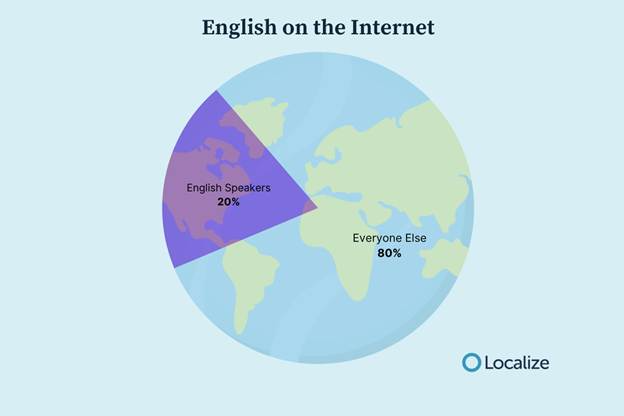
A DeepL survey of enterprise leaders reveals a startling truth: 69% of executives report that language barriers hinder their day-to-day operations, including their ability to grow. As global connectivity increases, these challenges will only grow more urgent.
That’s why many forward-thinking companies are embracing AI translation tools. 95% of executives believe AI translation tools will be essential to global operations by 2030.
There’s no better time to get ahead. Today’s AI tools can compress months of translation into minutes—helping you expand faster, reach more people, and improve ROI.
In this guide, you’ll learn how artificial intelligence is reshaping translation and how your business can stay ahead with the power of language AI.
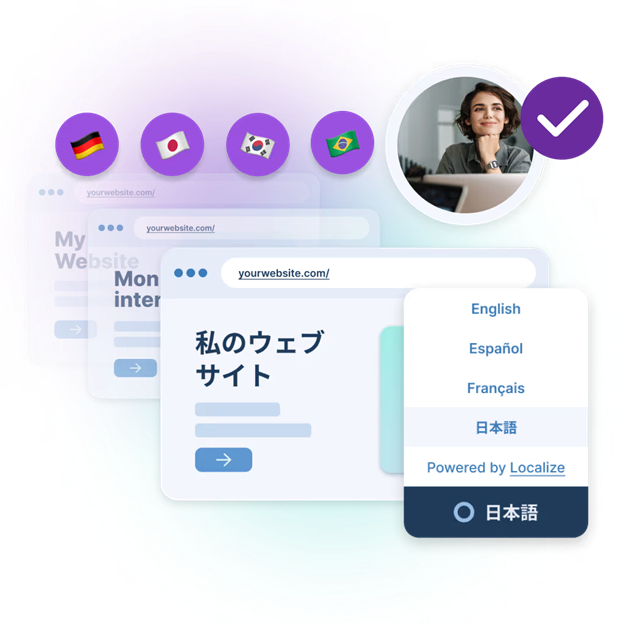
The latest advancements in AI have taken the world by storm. The explosive growth in language AI didn’t happen overnight.
From the first AI translation experiment in the 1950s to the rise of rule-based and statistical systems in the '80s and '90s, every milestone paved the way for smarter tools.
The most significant breakthrough came with neural machine translation in the 2010s, followed by AI-driven Large Language Models (LLMs). Nowadays, the best LLM tools can adapt to tone, terminology, and cultural nuance with human-like fluency.
Over time, AI translation moved through a few key phases:
Today’s AI systems learn from a vast dataset to improve over time, along with human corrections. This is why current AI translations are far more natural-sounding than older machine translation outputs.
AI tools like LLMs play a vital role in language translation by breaking down language barriers with accurate, textually relevant translations.
AI can produce a first draft in seconds, which used to take days. That frees up human translators to do higher-value work: refining tone, fixing tricky phrases, and making sure the message lands.

Businesses are increasingly adopting language AI because it’s scalable, cost-effective, and surprisingly accurate. With a combination of AI and a safety net of human expertise, it’s easier than ever to get localization projects to market.
Here’s a breakdown of how AI and human translation compare, and why the smartest teams use both.
Speed and Scale: AI Wins Here
AI can translate thousands of words in seconds. That makes it perfect for large-scale or time-sensitive projects like:
If you’re juggling dozens of languages or racing to meet a deadline, AI delivers unmatched speed and efficiency.
Cost Efficiency: Lower Translation Spend
AI also slashes translation costs, primarily when used for first drafts. Instead of paying for every word to be translated manually, savvy companies use AI to get the bulk of the work done and reserve human expertise for final edits.
This hybrid translation model is a game-changer for global teams managing content on a budget.
Quality and Nuance: Humans Still Lead
That said, AI doesn’t always get the details 100% correct. It can misinterpret context, guess incorrectly, and make mistakes. Human translators are still essential when:
Despite the advances in translation AI, it’s a best practice to involve a human translator as a safety net for accuracy and brand safety.
The Best of Both Worlds
So what's the best approach in website translation: human or machine?
We recommend a smart mix of both. Let AI handle the heavy lifting, then have a human translator step in to refine, review, and adapt the content. This is especially useful for high-impact content where mistakes aren’t an option.
Translator Roles Are Evolving, Not Disappearing
Don’t expect AI to replace human translators anytime soon. Instead, think of it as a way to supercharge their role. AI isn’t replacing human translators; it’s supercharging the role. Today’s translators are becoming post-editors and prompt engineers. They're using AI to work faster and smarter.
This reflects how many of our customers already work: they rely on AI for first-pass translations, then loop in human experts for the final polish, especially on content with legal, brand, or cultural risk.
In many cases, AI translation is surprisingly close to human-level quality, especially for common languages. But even with the latest advances, it’s not foolproof.
If you’re using AI to translate content, here’s what you need to know about when it’s safe to trust the output, and when you still need a human in the loop.
When AI Translation Is “Good Enough”
AI can handle low-risk content like:
For these cases, a perfect translation isn’t always necessary. As long as the meaning is clear and your customers’ needs are met, speed and efficiency win.
When to Bring in a Human
Certain types of content need more than “good enough.” Think:
In these cases, tone, nuance, and accuracy matter. A mistranslation could hurt your brand or worse, cause compliance issues. AI can help you start translation projects, but a human editor should always take it across the finish line.
How to Check AI Translation Quality
Want to stress-test AI translation output before it goes live? Try:
These techniques help you catch errors without reviewing every single word.
Not all AI translation tools are created equally. Whether you're translating a blog post, app interface, or legal disclaimer, choosing the right engine can impact cost, quality, and user experience.
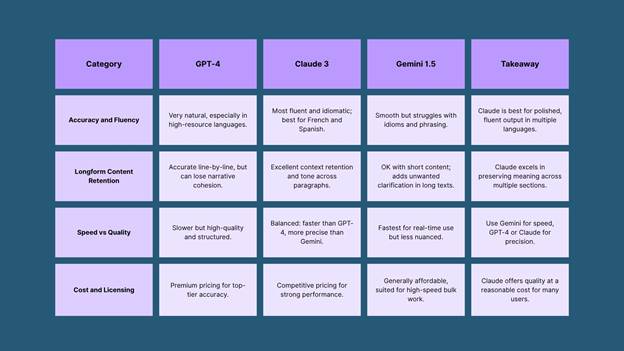
What Are The Options?
There are several established AI translation engines:
Full-service translation platforms like Localize, Weglot, Lokalise, and Smartling integrate with popular AI models and offer built-in workflows and translation management.
Why AI Integration Matters
Most platforms support a range of translation models. You can match the engine to the content, using one for blog posts, another for technical docs, and so on. Many businesses run side-by-side tests with multiple AI tools to see which produces the most reliable results for their industry or target languages.
How to Think About Pricing
Each AI translation provider handles pricing differently. Some charge by the character or word, while others offer usage-based subscriptions. Slight differences in quality may come with higher costs. So if you’re translating at scale, even small rate changes can affect your budget.
The best choice is one that fits both your quality expectations and any budget constraints.
Want More Control? Go Custom.
Did you know that translation platforms like Localize allow you to create custom translation workflows? That could mean uploading your own glossary of brand terms or feeding in past translations to train a model on your company’s tone and style. This is especially helpful for product names, taglines, or messaging that shouldn’t change from one language to the next.

The good news is that you don’t have to choose between AI and human translation. Modern translation tools like Localize let you keep a human in the loop. You get the speed of AI, with a safety net of human expertise when it matters most.
Whether you’re a marketer publishing a blog post, an engineer shipping a product update, AI can take care of the heavy lifting while keeping everyone aligned.
When new content is created, AI can instantly generate a draft translation. Then, the draft is automatically sent to the right people—translators for refinement, marketers for tone checks, and developers for implementation. No bottlenecks, no back-and-forth email chains.
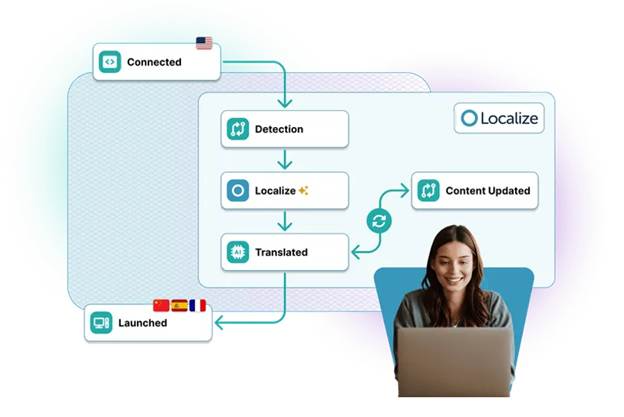
Most translation management systems (TMS), including Localize, offer built-in AI or seamless integrations with AI engines. This keeps all your human and AI translation efforts in one place—no more siloed processes or switching between tools.
AI is especially good at repetitive tasks. It can:
That gives human translators more time to focus on creative and complex language tasks that require expertise and nuance.
Bringing AI into the process doesn’t mean cutting out collaboration. Marketers, developers, and translators still work together in-platform—reviewing AI suggestions, tracking version history, and refining content to meet quality standards.
The differentiator of AI is that the collaboration process is faster, smoother, and more scalable than before.
Here’s an example of how Localize supercharges the translation process with AI to translate an entire website in less than an hour.
Step 1: Automated AI Translation for Websites
Let’s say you need to translate your entire marketing site into Spanish. First, you’ll add the Localize code snippet to your site. Next, enable the AI Style Guide to scan your current website for branding and style guidance on new translations.
Then, with the click of a button, you can automatically translate your entire site with the latest neural machine translation engines from Google, DeepL, Amazon, or Microsoft. These engines set the industry standard for translation speed, quality, and price, so the choice is yours.
Step 2: Quality Assurance with the On-Page Editor
With Localize’s On-Page Editor, you can preview your translated content directly on your site and edit in context before you publish. This is crucial because it allows quick tweaks if the AI translation doesn’t fit the space or context perfectly.
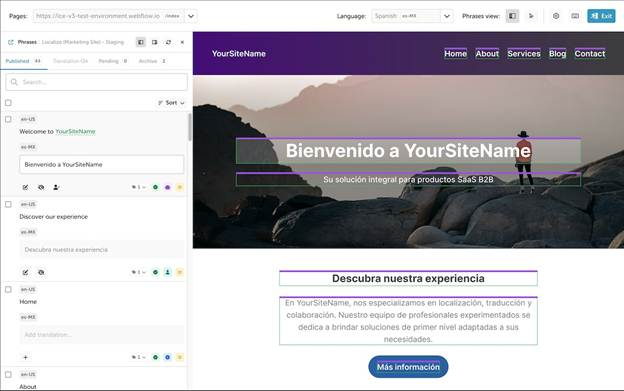
Step 3: Editorial Guidance with AI One-Click Actions
Next, AI One-Click Actions can help you fine-tune your newly translated website. For instance, let’s say that after translating a landing page into Spanish, a CTA button got far too lengthy. Localize’s Shorten AI action quickly recommends a concise translation with the click of a button.
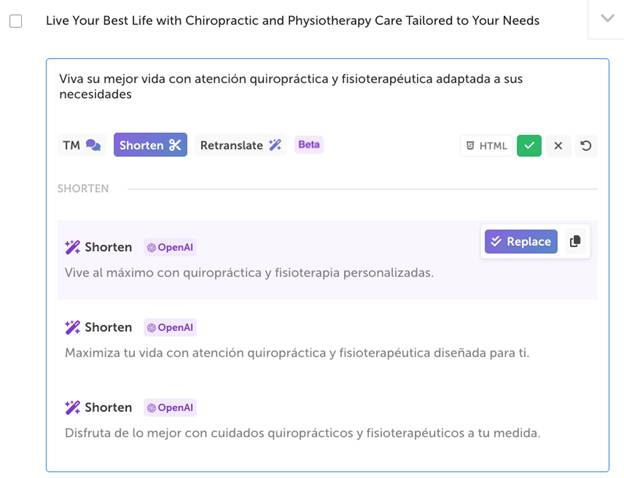
Plus, AI Insights can help with accuracy, tone, formality, and style, and provide a translation quality score with suggested improvements. It’s like having your own translation editor, powered by advanced LLMs.

Step 4: Human-in-the-Loop Refinements
For brand-sensitive content, we recommend layering in human translations. You can order professional translations from accredited linguists and translation services like TextMaster, Gengo, and more.
Step 5: Always-On AI Translation
Once your new website is published, the Localize platform intelligently recognizes any content changes so your site stays effortlessly up-to-date across all languages, continuously.
All in all, Localize brings AI translation, human editing, and live preview together to reduce friction and increase efficiency.
This makes it easy for any of your teammates, from marketers to project managers, to generate an AI translation, see it on-site immediately, and adjust wording—all without needing any technical help.
From speed to scale to stronger global engagement, AI translation helps companies grow and reach more people in record time.
“After implementing AI translation, Reddit quadrupled its daily active users and saw an 82% jump in international revenue.”
Faster Time-to-Market
AI can translate content in seconds, which means companies can launch products, publish updates, and localize websites at record speed. That speed translates into real market gains.
Take Reddit, for example. After implementing AI translation, Reddit quadrupled its daily active users and saw an 82% jump in international revenue. That’s the power of getting to market faster than the competition.
Cost Savings Without Cutting Corners
With AI handling the bulk of translation work, companies can translate more content without increasing budget. Human translators can then focus on reviewing high-value or sensitive content where tone and nuance matter most.
Scalability for Global Reach
AI makes it realistic to translate into 10, 15, or even 50+ languages. That’s something that would be cost- and time-prohibitive with human translators alone. Even small teams can manage a global presence because AI takes care of the initial lift.
Consistency and Brand Voice
Thanks to its ability to remember vast amounts of text, AI can help keep your messaging consistent. When paired with glossaries or translation memory, AI can reuse preferred terms and phrasing across content. This keeps product names, taglines, and tone on-brand.
Better Customer Experience
Customers are more likely to engage when content is in their native language. Even when AI is used for first-pass translation, it improves clarity, builds trust, and increases conversion rates in international markets. According to research from Shopify, offering new languages leads to 20% higher customer satisfaction, on average.
According to Slator, 96% of companies using automated translation technology reported a positive ROI on localization efforts.
“96% of B2B leaders reported a positive ROI from localization efforts, with 65% seeing at least a 3x return.”
For marketing and growth teams, that makes AI a powerful lever for a variety of metrics.
Productivity
AI significantly increases output without adding headcount. Let’s say your team traditionally translates 10 pages per day. With AI, you can generate draft translations for 100 pages in that same timeframe—and spend the next day refining them. That’s a 5–10x boost in productivity.
Time-to-Market
Accelerating time-to-market is one of the most overlooked ROI drivers. If AI shrinks your localization timeline from 3 months to 3 weeks, you unlock two extra months of revenue in that new market. That speed can pay for itself quickly.
Cost Savings
Human translation can cost around $0.12 per word. Translating a 10,000-word website might run $1,200 and take over a week per language. AI can do the first pass for under $10. Even with a human post-edit (at $0.03–$0.08 per word), the total cost is still dramatically lower. The more content and languages you work with, the more those savings add up.
The best ROI comes from using AI strategically: let it handle the bulk, then invest in human review for high-impact content.
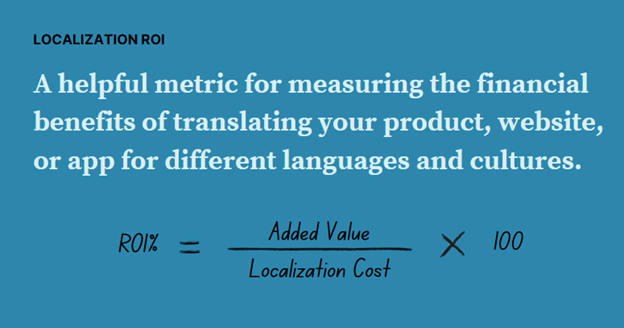
Here’s a simple formula for calculating localization ROI:
1. Set a data baseline.
Decide what to measure and use reports from Google Analytics, attribution modeling, or your translation management system (TMS) to set a baseline.
2. Determine the cost of localization.
Include all project costs, such as translation, LLM tokens, marketing fees, and associated expenses.
3. Calculate the added value of localization.
Measure the revenue or other benefits generated by the localized product.
4. Apply the ROI formula.
For an ROI percentage, divide the added value by your localization costs and multiply by 100.
AI translation can speed up localization and cut costs, but only if it's used thoughtfully. Here’s how to make the most of AI translation tools.
1. Start with Low Risk Content
Begin by applying AI translation to content that’s low-stakes, like product descriptions, support articles, or internal docs. This gives you a chance to evaluate accuracy and workflow efficiency before rolling it out to higher-impact marketing or legal content.
2. Use Glossaries and Style Guides
If your platform supports it, upload a glossary of key terms—like product names, taglines, or feature names—so AI doesn’t invent variations. A style guide also helps both AI and human reviewers keep voice and tone consistent across different languages. Together, these tools keep translations aligned with your brand, even when AI is doing most of the work.
3. Build in a Post-Editing Step
AI can do some heavy lifting, but human translators should always review the final product. A post-editing step helps catch fluency issues, tone mismatches, or misinterpretations. Give your reviewers clear guidelines: they don’t need to rewrite everything, but they should improve where AI fell short.
4. Create a Feedback Loop
Use edits from post-editors or in-country teams to strengthen your process. If you notice the same mistakes popping up, update your glossary, retrain your model (if possible), or consider switching engines for certain languages.
5. Watch Out for Privacy Issues
Always be aware of what kind of data you’re sending to an AI engine, especially if it’s cloud-based. Avoid uploading sensitive or confidential text unless you have proper agreements in place, or work with a privacy-certified platform like Localize.
6. Know When to Skip AI
AI is powerful but imperfect. For creative campaigns or nuanced messaging, it’s best to work with a translator. Thoughtful AI use means applying it where it adds value and sticking with the translation experts when human skill is needed.
Adopting new AI tools often comes with questions—some technical, some philosophical. Here's how to address the most common concerns from stakeholders and teams.
“Will AI Replace Human Translators?”
This is the biggest question, and the answer is no. AI is a supplement, not a replacement. It speeds up translation and handles high-volume content efficiently, but human expertise is still crucial.
“What About Quality and Accuracy?”
AI isn’t perfect, and yes, errors can happen. But most are minor and easily corrected with a review step. The key is using AI where it makes sense and consistently applying human oversight for high-impact content. Many companies start by testing AI on sample texts to see what level of editing is needed.
“Can AI Match Our Brand Voice?”
A common concern is that AI won’t understand your brand. Tools like style guides, glossaries, translation memory, and sample inputs help AI maintain your preferred terms and phrasing.
And with a human in the loop, you can keep your messaging consistent across all markets. Platforms like Localize make this even easier by managing these assets in one place.
“Will AI Work With Our Tech Stack?”
You don’t need to be a developer to make AI translation work. With solutions like Localize, integration is simple, with no coding required. Translations are applied directly to your website or app, with built-in features like in-context AI editing and live preview to ensure everything looks right before you publish.
“Will Our Data Be Safe with AI?”
Security matters, especially when you’re sending content through third-party AI services. Localize uses encrypted connections and does not store your content long-term without consent.
Many supported AI engines also comply with industry standards for privacy and data protection. If needed, you can keep sensitive content out of AI workflows entirely or run translations through internal systems with strict access controls.
“Can AI Translation Handle Lesser-Spoken Languages?”
AI excels with widely spoken languages like English, Spanish, and Chinese. For low-resource languages, output quality can vary. That said, language support is improving fast.
Localize supports AI translation for a wide array of languages and can combine it with human translation where needed to maintain accuracy and fluency across all of your assets from landing pages to mobile apps.
AI translation has already come a long way, but the next wave of language AI innovation promises to go even deeper, smarter, and more personalized.
Here’s what’s on the horizon.
Smarter Models, Better Context
AI translation engines are improving rapidly. Future models are expected to handle nuance better—like slang, idioms, or industry-specific jargon—and produce even more accurate, context-aware output.
Real-Time Translation
Real-time translation is moving from concept to reality. We’re already seeing progress with live AI translation for chat, video subtitles, and even voice. Soon, customer support reps might chat with users across languages in real time without switching tools.
Multimodal AI
In the near future, AI will be able to translate not just text, but audio, video, and images as well. Multimodal AI makes it easier to instantly adapt product images, demos, and videos for new markets.
Tighter Integration with Business Tools
Translation will get even more deeply embedded in how teams work. Imagine AI automatically detecting changes on your site and updating translations instantly. Or writing a product description and seeing a live preview of how it reads in five other languages, without leaving your TMS.
Smarter Personalization
We predict even more personalized translation, where AI adjusts tone and phrasing based on audience preferences. For example, a landing page in French might automatically shift from formal to casual tone depending on the region or customer segment.
AI has redefined what's possible in translation and localization.
Companies can translate more content, into more languages, faster—and at a lower cost—than ever before. And when used with the right workflows, AI amplifies human expertise without replacing it.
Businesses that adopt AI-powered translation can reach global audiences faster, create better multilingual experiences, and move into new markets with confidence.
A DeepL survey found that 96% of B2B leaders reported a positive ROI from localization efforts, with 65% seeing at least a 3x return. This aligns with Shopify’s research, which shows that localized personalization leads to 20% higher customer satisfaction.
If you’re new to AI translation, it’s best to start small and build from there:
Platforms like Localize make this easy, offering AI-powered translation built into a streamlined workflow. You’ll be able to test multiple AI engines, integrate glossaries, and maintain brand consistency while speeding up your process.
Curious how it all works in practice?
Book a demo or start a free trial of Localize to see AI translation in action. Our team can walk you through integration options, quality assurance tools, ROI calculations, and more ways to make AI a trusted part of your growth strategy.

Brandon Paton, CEO and founder of Localize, is dedicated to helping businesses extend their global reach through impactful localization strategies. His leadership drives Localize's mission to empower companies in managing multilingual content, enhancing their international presence and customer engagement.
Transform your event management journey from concept to analysis with Releventful. Elevate each step with our comprehensive tools designed for unforgettable event experiences.
Explore our features now!